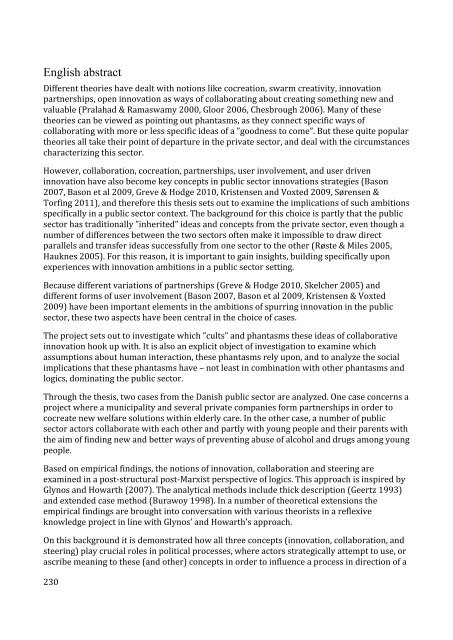phd.Nana
phd.Nana
phd.Nana
Create successful ePaper yourself
Turn your PDF publications into a flip-book with our unique Google optimized e-Paper software.
English abstract<br />
Different theories have dealt with notions like cocreation, swarm creativity, innovation <br />
partnerships, open innovation as ways of collaborating about creating something new and <br />
valuable (Pralahad & Ramaswamy 2000, Gloor 2006, Chesbrough 2006). Many of these <br />
theories can be viewed as pointing out phantasms, as they connect specific ways of <br />
collaborating with more or less specific ideas of a ”goodness to come”. But these quite popular <br />
theories all take their point of departure in the private sector, and deal with the circumstances <br />
characterizing this sector. <br />
However, collaboration, cocreation, partnerships, user involvement, and user driven <br />
innovation have also become key concepts in public sector innovations strategies (Bason <br />
2007, Bason et al 2009, Greve & Hodge 2010, Kristensen and Voxted 2009, Sørensen & <br />
Torfing 2011), and therefore this thesis sets out to examine the implications of such ambitions <br />
specifically in a public sector context. The background for this choice is partly that the public <br />
sector has traditionally ”inherited” ideas and concepts from the private sector, even though a <br />
number of differences between the two sectors often make it impossible to draw direct <br />
parallels and transfer ideas successfully from one sector to the other (Røste & Miles 2005, <br />
Hauknes 2005). For this reason, it is important to gain insights, building specifically upon <br />
experiences with innovation ambitions in a public sector setting. <br />
Because different variations of partnerships (Greve & Hodge 2010, Skelcher 2005) and <br />
different forms of user involvement (Bason 2007, Bason et al 2009, Kristensen & Voxted <br />
2009) have been important elements in the ambitions of spurring innovation in the public <br />
sector, these two aspects have been central in the choice of cases. <br />
The project sets out to investigate which ”cults” and phantasms these ideas of collaborative <br />
innovation hook up with. It is also an explicit object of investigation to examine which <br />
assumptions about human interaction, these phantasms rely upon, and to analyze the social <br />
implications that these phantasms have – not least in combination with other phantasms and <br />
logics, dominating the public sector. <br />
Through the thesis, two cases from the Danish public sector are analyzed. One case concerns a <br />
project where a municipality and several private companies form partnerships in order to <br />
cocreate new welfare solutions within elderly care. In the other case, a number of public <br />
sector actors collaborate with each other and partly with young people and their parents with <br />
the aim of finding new and better ways of preventing abuse of alcohol and drugs among young <br />
people. <br />
Based on empirical findings, the notions of innovation, collaboration and steering are <br />
examined in a post-‐structural post-‐Marxist perspective of logics. This approach is inspired by <br />
Glynos and Howarth (2007). The analytical methods include thick description (Geertz 1993) <br />
and extended case method (Burawoy 1998). In a number of theoretical extensions the <br />
empirical findings are brought into conversation with various theorists in a reflexive <br />
knowledge project in line with Glynos’ and Howarth’s approach. <br />
On this background it is demonstrated how all three concepts (innovation, collaboration, and <br />
steering) play crucial roles in political processes, where actors strategically attempt to use, or <br />
ascribe meaning to these (and other) concepts in order to influence a process in direction of a <br />
230


